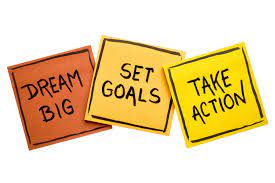
Don’t Just Set Goals. Build Systems
It’s that time of year again.
The cycle never gets old.
Let me guess… You’re probably reflecting on what a treacherous year it’s been.
The trials and tribulations you’ve had to overcome.
Yet you are highly convinced next year will be different…
It won’t.
I hate to be the party pooper, but I genuinely want the best for you, so I will tell you as it is…
At the beginning of 2022, you probably set goals you want to achieve for the year, right? Lose weight, clear debt, learn a high-ticket skill, etc.
Did you achieve it?
If you did, I’m not talking to you — click the “X” button in the top right corner of your screen.
But if you didn’t, I want to help you break the habit of setting lofty goals that never get realized.
I want to share with you the technique I’ve used to transition from:
- a taekwondo fighter who was once tipped to represent team GB at the 2012 Olympics
- to a footballer who walked away from a professional contract
- to a preacher leading a congregation of 70+ youths
- to a machine learning engineer and writer whose stories have been viewed more than 2.1 million times in the past two years.
All in the space of a decade.
As you read the remainder of the story, keep an open mind.
I will leave you with practical steps you can implement from today that are guaranteed to transform the outcomes you achieve for 2023 and beyond.
Like the late Albert Einstein used to say, “Insanity is doing the same thing over and over and expecting different results.”
The problem with goal setting
We’ve all been sold a lie.
Goal setting is not how you achieve the things you want in life.
A goal is required for direction but to think it is how you will achieve what you want is flawed.
Here’s why:
#1 The positive fantasy trap
It’s easy to become over-invested in achieving your goal.
You know… when the only thing you can think of is achieving the goal.
The excitement. The joy. The relief.
This is called a “positive fantasy.”
It’s not healthy.
Psychologists have found the number one way your brain can unintentionally deter you from realizing your goals is by fantasizing.
Positive fantasies allow you to indulge in the desired future mentally…
You can taste the sensations of what it’s like to achieve your goal in the present — this depletes your energy to pursue your desired future.
You’re also not alert to the obstacles you will inevitably face, which leaves you stagnant upon encounter.
#2 The outcomes first trap
Goals hone in on outcomes…
This doesn’t take into consideration the development required to maintain the outcome.
Why do you think 70% of lottery winners go broke and a third declare bankruptcy within three to five years?
The symptom is treated (being broke), but the cause (lousy spending habits) is untouched.
It’s easy to think the outcomes are the problem when things look gloomy — you’re conscious of them —
When you’re broke, you feel broke.
When you’re overweight, you feel overweight.
But it’s easy to miss the cause for the recurring outcomes because they usually occur at a subconscious level.
Yes, you can win the lottery or get liposuction…
But if you continue to spend recklessly or eat junk food all the time, you’ll be right back to where you started.
Solving problems at the outcome level is temporary.
#3 The failure state trap
Have you ever thought, “when I achieve X, I’ll be happy?”
That is the failure state.
It’s a by-product of adopting the goal-first mentality.
Happiness is pushed to some later date in the future while your present self battles with the misery of the current moment.
The reason it occurs is simple: goal orientation creates either-or conflicts —
“you are either a failure (you have not achieved what you want), or you are a success (you have achieved what you want).”
There’s no middle ground.
I’ve fallen into this trap countless times.
What are systems?
Systems are the moving force for the goals you set.
They preserve the need for self-control and increase your overall happiness in the long run.
“Goals are good for setting a direction but systems are best for making progress.”
— James Clear, Atomic Habits
Here are a few examples of effective systems:
→ Objective: Write a book in a year. System: Write “two shitty pages a day” (as Tim Ferris would say).
→ Objective: Grow on social media. System: Post daily.
→ Objective: Master an instrument. System: Practice the fundamentals of the instrument daily.
The importance of systems
Systems introduce structure.
For example, the UK uses a credit system to determine your borrowing eligibility.
I’m not saying it’s perfect, but it takes the guesswork out of who the bank thinks will likely pay them back when they borrow money.
The same is true for your life.
Systems eliminate the guesswork about what you must do to achieve what you want.
Goals without systems create chaos in your life.
Here’s why you need them:
#1 Systems focus on the skill
Focusing on the skill embraces process — “I’m not yet where I want to be, but if I do X, I’ll be a step closer.”
Even if you do not achieve your goal, you have developed a skill that will stay with you forever.
All of your efforts are not in vain.
#2 Systems create life-long change
Unlike goals, systems emphasize process…
Systems treat the cause of a problem, and the symptoms (outcomes) change as a by-product.
“Fix the inputs, and the outputs will fix themselves.”
— James Clear
For example, treating lousy spending habits may result in you having more disposable income.
#3 Systems embrace happiness in the present
Systems acknowledge the grey zone between where you want to be and where you want to go.
It’s not just black and white.
You don’t have to wait until you achieve what you want before you can be happy.
You can be happy now…
You can be happy now by falling in love with the sensation of moving toward where you want to be.
If you’ve read this far, you’re probably wondering how to create a system.
I’ll show you in five simple steps.
How to create a system in 5 simple steps
The secret to building an effective system is incorporating small, consistent wins into your life.
You must have something you can celebrate each day.
Brace yourself.
This will be the most practical part of the article; Grab a notepad and pen, and work through these steps with me.
Step 1: What do you want to achieve?
Sit down and think about what you want.
Be honest with yourself, and don’t be afraid to go deep.
For instance, saying “I want to be a professional footballer” is not detailed enough if the truth is you want to be one of the best professional footballers playing in a top-four club that competes for titles in England and Europe.
The goal of this step is to completely define what is on the other side of the river.
The following steps will show you how to build a bridge and walk across it.
Step 2: The five why’s
Everyone has goals they want to achieve — sometimes, people have the same goals as you.
What will set you apart from them is your why.
Your “why” is what fills you with a sense of mission.
But it is essential to identify where the core problem lies — the thing blocking you from where you want to be (Remember: systems treat the cause, not the symptom).
The five why’s technique is a great tool to discover exactly that.
It’s pretty simple; ask yourself why you want what you want, answer, and repeat the process four more times.
For instance, take the following scenario:
Why #1: Why do you want to be one of the best professional footballers playing in a top-four club that competes for titles in England and Europe?
Response #1: I have a chip on my shoulder. I want to prove people who doubted me wrong.Why #2: Why do you want to prove yourself to people who doubted you wrong?Response #2: So, in the future, people do not give up on me.
Why #3: Why don’t you want people to give up on you?
Response #3: It kills my confidenceWhy #4: Why does it kill your confidence?
Response #4: Because I’m very attuned to what people think of me.Why #5: Why are you very attuned to what people think of you?
Response #5: I have low-self esteem, and it hurts me when I feel like I’m letting others down.
Boom!
The root cause of our scenario cases problems is low-self esteem. The goal of their mission (to become what they want) is to build their self-esteem — which is something that can be worked on each day.
Step 3: Learn the core actions required
I like to think of this stage as building the bridge from where you are now to where you want to be…
The great thing about learning what you need to do is that you don’t have to come up with it by yourself.
It’s likely others have already achieved what you want.
All you have to do is find them and follow the trail they left behind.
The steps have already been created for you, don’t reinvent the wheel.
Step 4: Set implementation intentions
Now you’ve identified the actions required to get what you want, you must set intentions to implement them.
